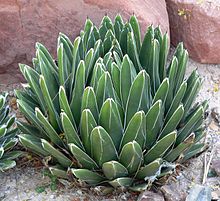Agave victoriae-reginae
| Queen Victoria's agave | |
|---|---|

| |
| Scientific classification | |
| Kingdom: | Plantae |
| Clade: | Tracheophytes |
| Clade: | Angiosperms |
| Clade: | Monocots |
| Order: | Asparagales |
| Family: | Asparagaceae |
| Subfamily: | Agavoideae |
| Genus: | Agave |
| Species: | A. victoriae-reginae
|
| Binomial name | |
| Agave victoriae-reginae T. Moore (1875)
| |
| Synonyms[1][2] | |
| |
Agave victoriae-reginae (Queen Victoria agave, royal agave) is a small species of succulent flowering perennial plant, noted for its streaks of white on sculptured geometrical leaves, and popular as an ornamental.
This agave is highly variable in form, but in general the rosettes are small and compact, growing to 0.5m, composed of short, rigid, thick leaves that are green with a pattern of distinctive white markings. The markings are generally along leaf keels or margins, giving a sort of polyhedral appearance. Marginal teeth are usually lacking, while the terminus of the leaf may include 1 to 3 spines, each 1.5–3 cm in length. Cream coloured flowers are borne in erect racemes up to 4m in length.
A. victoriae-reginae is found the Chihuahuan Desert in the Mexican States of Coahuila, Durango and Nuevo León, with about a half-dozen subspecies named. The situation is complicated by hybrids with a number of other agave species.[3][4]
It is cold-hardy as agaves go, and thus finds favor as a small accent in many northerly gardens. However it is recommended in the UK that this plant be kept in heated conditions under glass during winter. It has gained the Royal Horticultural Society's Award of Garden Merit.[5]
-
Plant
-
Leaf closeup
-
In bloom
References
- ^ Tropicos, Agave victoriae-reginae
- ^ The Plant List, Agave victoriae-reginae
- ^ Howard Scott Gentry, Agaves of Continental North America (University of Arizona Press, 1982) pp. 183–185
- ^ Moore, Thomas. Gardeners' Chronicle, new series 4: 485. 1875.
- ^ "RHS Plant Selector Agave victoriae-reginae AGM / RHS Gardening". Apps.rhs.org.uk. Retrieved 2012-08-25.



